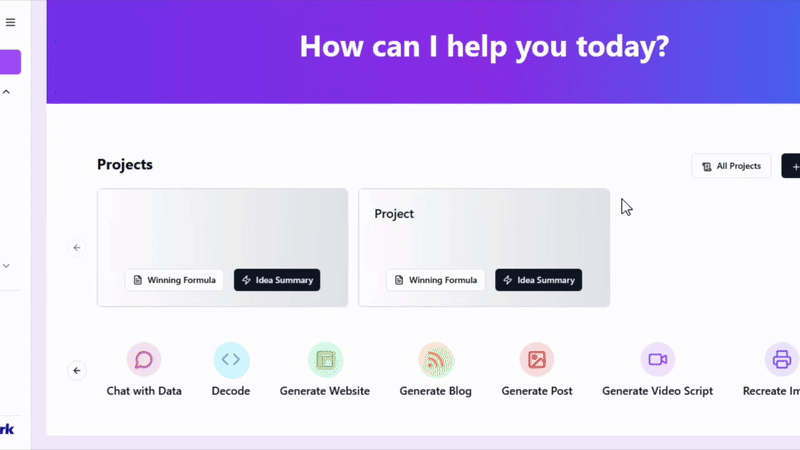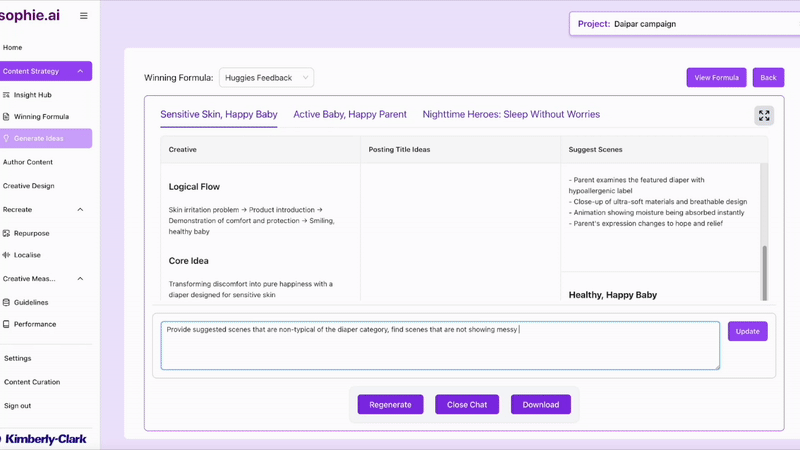What is Sophie?
Sophie is an enterprise AI agent that helps business leaders analyze sponsored influencer videos, identify the winning formulas behind high-performing content, and reuse those insights to generate new video ideas for Kimberly-Clark products.
Content:
Our Challenges:
-
Leo Dai: UX Designer / Researcher:
Wafa Khan: UX Manager:
-
Product Manager
AI Engineers
Marketing & Content teams
-
May 2025 - August 2025
-
AI Analytics & Content Generation
1.The product was developed largely in a black box, aiming to accelerate progress amid competition. The design team was brought in only after the MVP’s delivery and was expected to provide quick feedback within a short timeline.
2.In addition, since we were brought into the project halfway through, we had no clear understanding of Sophie’s purpose, how it was supposed to help, or what kind of value it was meant to bring to users. Therefore, we needed to request research resources for constructive UX input.
Our Approach:
Rather than pointing out flaws for the sake of critique, we focused on using objective evidence to drive design involvement.
Review information architecture for us to ease in the project and define UX flaws based on heuristic principles.
Usability data to validate assumptions with real user behavior
User flow to align improvement direction on a high level.
This approach grounded our UX input with real examples and actionable solutions, helping stakeholders reconsider the scope and granting us the additional time we needed from the initially tight timeline.
What we found from Information architecture review?
Since the product was developed without early UX involvement, many features are disconnected, repetitive, and difficult to understand due to an unclear information architecture and a lack of user-centered focus from initial heuristic analysis.
1.Unclear Product Goal
The homepage actions don’t align with user goals. The main CTA sends users into a confusing flow, leading them to a complex analytics dashboard after entering only basic project details—leaving them wondering, “Why am I seeing all these numbers when I’m still defining my project?”
2.Unintuitive User Flow
Sophie’s most valuable features are hard to use without clear visual guidance. Before switching to the “Decode” tab, there’s no cue that a key action is available—especially since the “Summary” tab looks like a static dashboard rather than an interactive workspace.
3. Fragmented Experience
There are many repetitive and missing steps throughout the user journey when completing actions in Sophie. For example, the “Create Winning Formula” button is redundant—it creates unnecessary friction, as the winning formulas should appear automatically after decoding the videos.
User Interviews
Through the heuristic evaluation, we familiarized ourselves with how Sophie was intended to function. Recognizing the risks these issues could pose to the user experience, we advocated for research despite stakeholder concerns about confidentiality and limited user access.
As a result, we only secured two user interviews, but the participants are selected with a seasoned and fresh point of view to help us validate our initial observations.
Social Content Manager
Led social campaigns before and well-versed about the detailed structures, requirements, and terminologies of brands insertion in influencers’ videos
New User
Product Owner - emerging markets
Wanting to use Sophie to learn from company’s resource and generate inspirational ideas but haven’t had hands on experience on social content
Advanced User
Defined Problems:
1. Sophie’s flat design hierarchy makes its core feature—creating winning formulas—hard to find and complete, distracting users from the main goal.
“When I’m doing it, I don’t not know where to go immediately.”
2. Without clear system feedback or progress indicators, users feel disoriented and unsure whether their actions worked or what to do next.
“I said generate ideas and then I come here and it's again asking me, ready to get started and generator.”
3. No personalization or flexibility in AI outputs — the system doesn’t adapt ideas to users’ context or leverage their saved winning formulas for tailored results.
“I need the AI to generate things that are different than this. Like, not the norm of a diaper, for example.”
CO-Design with Stakeholders
Having the same goal of helping users easily analyze and generate brand insertion ideas for influencers and agencies, we collaborated with stakeholders after sharing research insights to co-design focusing on:
Seamless User Flow
Connects users from discovering, analyzing, to generating ideas
Organized Documentation
Supports users in organizing and reusing their ideas.
Personalized AI Interaction
Enable users to adjust AI responses to fit their contextual needs.
Before diving into design details, we need to discuss UX strategies early, we gained strong stakeholder buy-in for the seamless flow direction.
For documentation and personalization, there are questions raised initially. Rather than forcing a definitive decision now, we chose to keep ideas open for further exploration. As we moved into design, these concepts became easier to evaluate with visual examples, helping the team reassess feasibility and prioritize what could be rolled out within technical constraints.
Reaching Alignment
As we discussed with Sophie stakeholders, the issues that need to be fixed are not quick and easy as improving a button style or banner layout as their beginning assumption.
While not all proposed updates were adopted instantly, we aimed to agree on a shared understanding of the design direction moving forward. The details of the execution part on design direction will evolve through continuous weekly collaboration, delivery, and feedback cycles.
Home > Start Here
Design execution
Following the information architecture aligned we starting to deliver screens starting from the top priority feature: Create Winning Formula starting from the homepage
Video Selection
Create Winning Formula
Generate Ideas
To help users more easily create and apply winning formulas for idea generation:
highlighted this feature on the homepage as a clear starting point.
Emphasizes the core elements — Formula, Ideas, and Content — across the project structure and quick actions, reinforcing how these components connect to help users focused on their creative flow rather than getting distracted by viewing all features at the same hierarchical level.
Home > Start Here
Since the goal of Sophie is to help users decode videos and using the same formula for scalable video ideas, they need to identify which bucket of videos are going to be used as the base reference examples.
Video Selection
Create Winning Formula
Generate Ideas
When designing this flow we have the vision of providing users clear guidance on each steps but we didn’t realize having too many breakpoints also complicated the flow
Home > Start Here
After users select their videos, Sophie analyzes the video scripts and identifies the most commonly used combinations of story elements, ranking them by performance. Users can then save these winning formulas as-is or adjust them based on their creative goals.
Video Selection
Create Winning Formula
Generate Ideas
The challenge in designing the ‘Create Winning Formula’ step was managing information density. Our goal was to help users decide which formulas to save by presenting meaningful insights for each one—while maintaining visibility to compare alternatives they might want to explore.
To address this, we implemented a progressive information display and optimized the table layout for responsiveness, ensuring that no critical details were hidden across screen sizes.
Home > Start Here
The winning formulas users saved will be used to generate video storyline ideas that later on shared with agencies to generate social content with steerable AI settings to adjust video genre and creativity to be suitable for selected social platforms and regions.
Video Selection
Create Winning Formula
Generate Ideas
At the idea generation stage, the main challenges stemmed from users’ diverse contextual needs:
Adapting to regional adoption needs across global teams
Balancing innovation with standardized storytelling
Reconciling improvisation vs. regenerated consistency
Preventing overfocus on top ideas while missing valuable alternatives
Impact Measurement
While Sophie continues to evolve with new features in development, the content strategy modules — Winning Formulas, Generate Ideas, and Insight Hub — were launched in August 2025.
Winning Formulas and Generate Ideas form the creative core of Sophie. In parallel, Insight Hub focuses on performance measurement, giving users a clear view of how their influencer videos perform across platforms.
Within three months of launch, we observed steady growth in video uploads and engagement. Month-over-month, Sophie showed:
+14% increase in total videos
+18% increase in likes
+11% increase in comments
–0.5% slight dip in total views
These trends indicate a shift toward more resonant, higher-quality content, where fewer views generated stronger engagement.
The Next Step
While engagement increased after Sophie’s launch, there are external factors—such as seasonal campaigns, influencer mix, and platform algorithm changes—might also have influenced performance.
More importantly, we wanted to know how valuable users found the ideas generated by Sophie and whether those ideas truly supported their creative process. To measure this, we used FullStory to observe user journey of ideas generation and we found this:
While engagement increased after Sophie’s launch, there are external factors—such as seasonal campaigns, influencer mix, and platform algorithm changes—might also have influenced performance.
More importantly, we wanted to know how valuable users found the ideas generated by Sophie and whether those ideas truly supported their creative process. To measure this, we used FullStory to observe user journey of ideas generation and we found this:
Most users successfully reached the idea generation stage, but over half left their ideas in Sophie without sharing or downloading them. Follow-up interviews revealed key pain points and opportunities to help users build trust in AI-generated ideas and better integrate Sophie into their creative workflow:
Provide deeper insights or predictive metrics on idea performance to build users’ confidence in AI-generated ideas
Offer shareable export options, such as a downloadable campaign brief format, instead of a sandbox-like output.
Encourage more innovative thinking by adding an “innovation-driven” improvise prompt like: “Generate ideas inspired by industries beyond CPG to explore unconventional creative directions.”
Enable music or video pairing so users can create demo-ready ideas suitable for agency presentations.
Thank you!
Some of these features we’re currently experimenting and hope to bring them into Sophie soon. Thanks for staying till the end of Sophie’s story — check back for new updates as the journey continues!



















